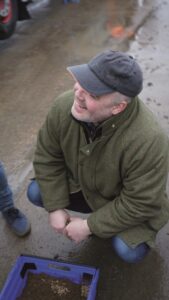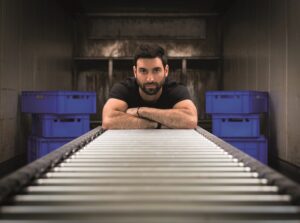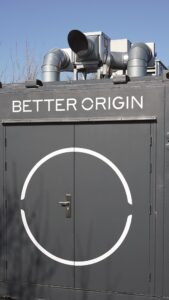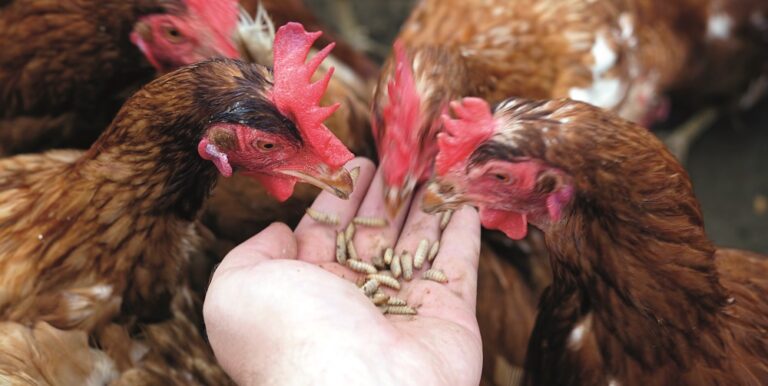A new insect farm concept could signal a move towards a sustainable source of poultry feed
Feeding insects to poultry has long been touted as an environmentally friendly way to both cut down on imported soya and deal with our country’s food waste problem. Insects are high in protein and can convert a waste product efficiently into larvae that poultry find tasty and stimulating, solving two problems at once. But there have always been logistical problems that have so far stopped commercial insect production working at scale.
But now, a trial has taken place on egg producer Charles Mear’s farm in Cambridgeshire (a finalist in the 2019 National Egg & Poultry Awards) of a new concept: an insect-production unit housed in a shipping container, which means the insects are produced on site and taken directly to the birds that will eat them.

The concept has been created by the start-up firm Better Origin, and has been named the X1. It is being touted as a ‘fully-automated insect mini-farm’. Founder and chief executive Fotis Fotiadis says the unit converts local waste, such as fruit and veg, agricultural residues and industrial food waste, into high quality animal feed in the form of insect larvae.
The X1 has an app-based user interface that means the farmer always knows exactly what is going on inside the unit at any given time. “Until now there was no accessible way for food producers to turn abundant feedstock or food waste, into useable food,” says Fotiadis. The larvae are high in protein and can replace part of the soya in poultry rations. Currently, the insects make up 5% of the total feed on Mears’ farm, but in future it could be a higher percentage, says Fotiadis.
Q&A with Fotis Fotiadis

How did the concept come about?
We have been going for about four years. We came out of the university of Cambridge [Fotiadis and co-founder Miha Pipan, the start-up’s chief scientific officer] and at the time we were all students there. We participated in a sustainability themed competition and we saw the problem of waste and food production as one of the biggest challenges facing the future. We wanted to see if there was anything new that we could explore to help us to tackle this big problem and that is how the insects came about. At the time it was considered a bit crazy, we talked to people and told them we would grow insects to convert waste food and at the time it sounded a bit weird but all we are doing is taking a process that exists in nature and using technology we integrate it with the modern food system, taking the insects and feed them to animals.
Tell me about the practicalities of having an XI unit on farm.
The system is literally in a shipping container on the farm, in one end you put the food waste and the young larvae. The whole thing is fully autonomous so the farmer doesn’t need to become an expert in growing insects. The management of the container takes about an hour a day and that is to take out trays of insects to feed to the poultry and to put in younger ones. This is the only practical element that the user needs to do. However we are already working on a system upgrade that will be rolled out later this year and will see the labour time cut down to 15 minutes and our end goal is to cut it down to zero. The system is full of trays of insects and when he is ready, the farmer takes the trays out and takes them to the poultry. The insect used is the black soldier fly. It is really efficient and it has a rapid cycle of about 10-14 days. There is no waste with the process. There is a by-product, the frass, but that is really good for soil, so we are taking the full tray, and putting it in the range. Right now they are spread out in the scratch yard but we are trialling an automated system [conveyor system] which would be a very seamless approach.

What kind of feedstock is used?
That depends on several things. Where is the farmer located? Does he have any type of waste on-site or near by? At the moment we recommend using seconds-quality grain. However even from our next system we will be looking to integrate food waste from the farming supply chain into the system and really start closing the loop.
Is this a replacement for soya?
We have been industrialising soya for decades and it is cheap, so you can’t just get rid of it right away, so our idea is much more sensible and practical in the sense that if you could replace 5% of the soya in poultry feed, that is the environmental equivalent of removing 1.5 million cars from the streets. Right now, we feed them at 5% of the soya ration. We can go up to 10% or 20% but we want to find something that makes sense for the stakeholders right now. And as there is a bigger push for scaleability, that will increase, but if we removed all the soya there wouldn’t be anything to feed the chickens with, simply not at that scale, it wouldn’t be viable.
So what are the benefits of insects for poultry?
Feeding whole live insects improves a lot of things for the animal. We have done extensive trials with the University of Bristol, and we have seen a significant improvement in the health and welfare of birds fed on insects, with better gut health, better foot health, and less keel bone damage. Interestingly, healthier hens produce more eggs and more first-class eggs. So, there is a reason chickens forage for insects; at the moment they get very dry soy feed, and insects help their guts, offer them more nutrients, and that makes them healthier and happier. For some reason, it is assumed that by improving welfare you decrease productivity. But with our solution we offer a significant improvement in welfare and uptick in productivity as well.
What kind of level of investment would farmers need to make?
It’s something we’ve given a lot of thought to. So instead of paying up front, the farmer eases the X1 on a monthly basis, so it doesn’t need a big investment So, it is light touch model, we store it on the farm, and the farmer pays a monthly fee. Then depending on who the customer is, we help with sourcing substrate [the feedstock] and we help with the maintenance. How many are out there? We have just installed the first one and it has been there for three months, and we have just started manufacturing the second one. The Mears’ really understand the circular economy.
What are your ambitions?
We think there should be one on every single farm, literally, I think it is a necessity. It reduces soy, reduces antibiotic use, makes money, improves welfare of the hens, it makes sense at a social level and economic level. Our vision is every single farm.
What big challenges have you faced?
There are countless challenges at every stage. What was hard was it is a completely new industry so we had to invent the technology, understand the science, and find the solutions that could be commercial. We had to figure out how to do it, then try to move the industry forward. So, the technology part was very hard. It’s a long cycle of R&D, then you have to convince farmers to start adopting something new. I think we have done a good job, we have identified the benefits and now we are seeing a lot of traction and people recognising what we are doing.
Has any research been conducted on consumer reaction to poultry fed on insects?
There have been some studies. Poultry ranks number one for consumer acceptance, 70% of consumers said they were totally fine with chickens eating insects. When you think of chickens, you think of foraging for insects, even in the developed western world.
Are you targeting broiler farms as well as layer farms?
Yes, we have already done a trial with the University of Turin, Italy, so it is the second stage and then we will be able to satisfy the market.


